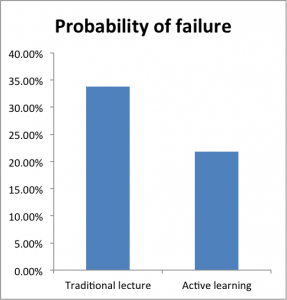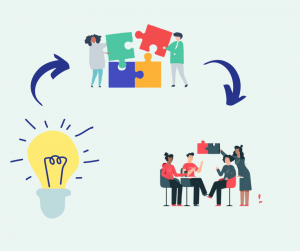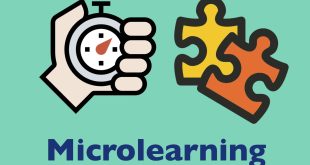“Spoon feeding, in the long run, teaches us nothing but the shape of the spoon.” E.M. Forster
Table of Contents
Let Go of the Past
Indeed, the image of a classroom in which the teacher is using didactic instruction is quite unappealing for students today. This one-sided method can be unfair for students as it steals away any opportunity for them to think for themselves, innovate, and actually grow as learners.
In addition to that, it is a pretty boring task to be sitting in the classroom as a listener with no say in the topic being discussed. Several studies have proved the importance of going the extra mile when it comes to teaching techniques. This is where active learning comes into the equation—a teaching philosophy that transforms the whole learning experience for students at all educational levels. This article will help teachers and university instructors understand the best strategies for active learning in online continuing education and how to use them in their classes.
What Is Active Learning?
Active learning is a method of instruction where students are expected to engage in the learning content. This places the teacher in a facilitator role instead of the traditional teacher-student dynamic. Given the name, this method of learning is more focused on getting the best out of the learner, allowing them to actively learn through more student-centred approaches.
This video is an interesting visualization of active learning and the reasons that make it an effective educational strategy.
Get started Skolera for FREE
Why Use Active Learning?
Active learning is a term that is basically based on an educational theory called constructivism that suggests that students do not passively learn; instead, their learning process is more about building and construction. This theory was proposed by the Swiss psychologist Jean Piaget who was immensely interested in children’s psychological development. The connection between the two theories is quite interesting as both active learning and constructivism highlight the fact that learning is interactive, cooperative in nature.
If students are allowed to think independently and actively engage with the learning content, they will definitely perform in a better manner. Studies have indicated that students who study in the traditional learning environment are more likely to fail classes than active learning students. The active learning experience is also quite rewarding for instructors as well; they report more enjoyable and productive classes where their students are less idle and more energetic.
Educators have long been weighing on the notion of learning something new; the process itself does rely on the act of listening to a teacher. However, learning does not stop at this point. It is much more effective for students to be involved in processes of reading, writing, solving problems, and taking part in discussions among other things.
Therefore, the process of learning can be characterized as being complex and demanding even. Benjamin Bloom, for example, has created Bloom’s Taxonomy for categorizing the whole learning process where learning is levelled in a sequential manner rather than haphazardly.
This article discusses Bloom’s Taxonomy and provides suggestions for teachers to use it in the classroom.

Image source: Brame, C. (2016). Active learning. Vanderbilt University Center for Teaching. Retrieved from https://cft.vanderbilt.edu/active-learning/.
Douglas R. Barnes (1989) suggested seven principles for the success of active learning in the classroom. These principles are essential for the full implementation of this learning strategy with students. Purposive, reflective, negotiated, critical, complex, situation-driven, and engaged are the main features of what an active learning agenda should be for the classroom.
- Purposive: for the task being taught to be aligned with the students’ needs
- Reflective: it is important that students can provide their own reflections after the lesson content
- Negotiated: negotiation between teacher and student about the goals and objectives of learning is necessary
- Critical: for the students to acknowledge the diversity of methods for learning the content
- Complex: this would allow students to compare and contrast the lesson content with real-life; it would also give them space to construct reflective analysis
- Situation-driven: for the success of the given learning tasks, the situation should be clear and taken into consideration
- Engaged: teachers should make activities interactive and based on real-life
To gain an insight into some teachers’ experiences with the implementation of active learning, watch this video.
Strategies for Active Learning in Online Continuing Education
Implementing active learning within any learning environment requires a decisive role on the part of the teacher. Planning, researching, and experimenting are the key methods for which to decide on the ideal teaching framework for your class. The process itself could require some effort at first but the outcomes will definitely be rewarding and fruitful.
In the case of continuing education, the crowd could seem tough at first given the age of the learners and their subsequent expectations. Implementing active learning strategies to adult learners is quite different from doing that with middle school students or even high schoolers. For a successful and smooth framework, you will need to study the learners’ psychology and determine what could be appealing to them in terms of content delivery and techniques.
This article will provide you with a few strategies to use in your lecture if you teach adult students in a continuing education environment. These strategies could be used either on-site or online; they depend, however, on your own convenience.
Book FREE Live Demo Now

- Think-pair-share
This strategy could simply be applied by asking a general question for the class, giving students the time to think about it individually, and asking them to discuss their thoughts in pairs. After that, students can share their thoughts with the whole class to promote a more detailed and broader discussion.
In an online environment, this requires some prior organization on the part of the instructor. Via Zoom, for example, students can communicate with their peers using the chatbox. This strategy is perfect if you want to enhance students’ communication, presentational, and deep-thinking skills.
- Student debate
Traditional face-to-face student debates are quite effective for idle classes that require a boost of engagement. They teach students the importance of having a voice, how to lead an argument, and the best technique to respect others’ perspectives. Carrying out a student debate online can seem pressing at first. The key, however, is to properly plan it and keep in mind the occasional voice lags and unstable internet connections.
You can begin by posing a controversial question: create a poll to identify the for and against teams and give each team some time to discuss their arguments. After that, a representative speaker from each team can lead the whole debate. This strategy will definitely keep your students interested and willing to contribute, unlike traditional lectures that are usually one-sided and mundane.
- Reaction to a video
Video lessons have been an integral part of university curriculums. Changing the mode of instruction in this manner will enhance students’ retention levels and interest as well. Because visuals are known to enhance learning by 400%, you should definitely integrate videos, documentaries and visual learning materials in your class.
To ensure overall comprehension, you can pause at a few time intervals to ask some questions. Another technique to make use of this activity is to make that video a part of a larger assessment, as a project for example. Remember to keep your videos clear, organized, and informative as possible.
- Learning by teaching
This strategy subverts the whole teacher-student roles in the classroom. Instead of a conventional lecture in which the teacher is doing all the talking, students should be allowed to actively contribute as well. Studies have found that when students teach the material they are supposed to be taught, they understand and retain information better.

In your next online class, allow your students to create presentations at the end of the lecture. Each group of students can choose a topic and discuss it with the rest of the class. They can even prepare questions to encourage other students to participate.
- Virtual labs
Virtual labs have become an increasingly necessary tool for science majors in the past few years. The benefits of implementing virtual lab software in your classroom are countless, from performing difficult and risky experiments easily to saving teachers the time and effort needed in running and maintaining real-life labs.
Of course, this software will help you implement active learning as it will allow students to actually participate in scientific experiments instead of listening to the instructor describe the experiment on the board.
- Virtual field trips
If you are an instructor in the field of archaeology, museology, or history, virtual field trips would be an immense addition to your online lectures. Educational virtual trips will definitely appeal to your students who constantly learn through textbooks and written material. This will be visually appealing and interesting to implement as well. Several websites offer this experience for historical places, artefacts, museums, etc.
- Decision-making activities
Decision-making and problem-solving are key elements of any learning process. These skills emphasize the level of retention for students and their ability to grasp the subject at hand. For this reason, it could be really helpful to pose a certain problem, conundrum, or issue to the class and allow them to reach solutions in groups.
They should be encouraged to consider all the possible solutions to the problem and the proposed methods of dealing with it. This strategy could be especially effective in history and political science fields.
This article discusses Active Learning and its effect on students’ character development.
Active learning is an educational strategy that can be implemented in several manners. The era of the traditional teacher to student instruction has ended; the time has come for a complete change in the way students learn and receive knowledge. This article discussed the criteria that form the foundation for a successful active learning plan and proposed several strategies for teachers in continuing education to use in their online classes.
Join Skolera Now for FREE
Sources:
Active learning in online teaching: Center for teaching innovation. (n.d.). Retrieved April 18, 2021, from https://teaching.cornell.edu/resource/active-learning-online-teaching
CEI classroom Activities/assessments matrix. (n.d.). Retrieved April 18, 2021, from https://docs.google.com/document/d/1QMZC9igdgPggg1SC-NbOuAB05WnG3ujAtJ1zNEHssx4/edit
Constructivism. (2020, December 08). Retrieved April 18, 2021, from http://www.buffalo.edu/ubcei/enhance/learning/constructivism.html#:~:text=Constructivism%20is%20the%20theory%20that,%2Dexisting%20knowledge%20(schemas)
Lynch, J. (2017, June 22). What does research say about active learning? Retrieved April 18, 2021, from https://www.pearsoned.com/research-active-learning-students/#:~:text=Active%20learning%20refers%20to%20the,engaged%20in%20the%20learning%20process.&text=In%20fact%2C%20well%2Ddesigned%20lectures,.%3B%20Clark%20%26%20Mayer
Mcdaniel, R. (1970, June 20). Active learning. Retrieved April 18, 2021, from https://cft.vanderbilt.edu/guides-sub-pages/active-learning/#basis
What is Active Learning? (n.d.). Retrieved April 18, 2021, from https://www.smartsparrow.com/what-is-active-learning/
 Skolera LMS Blog Educational Technology Articles and News
Skolera LMS Blog Educational Technology Articles and News




